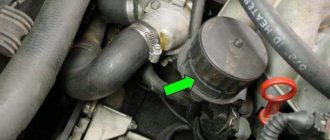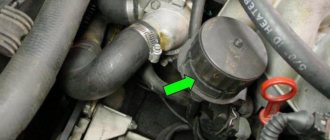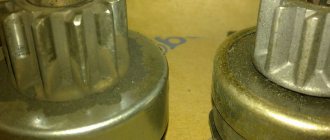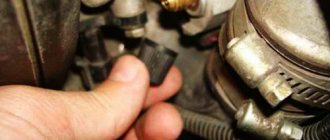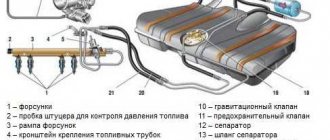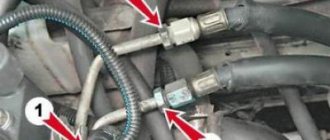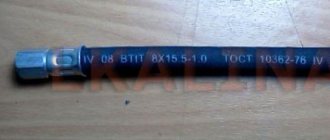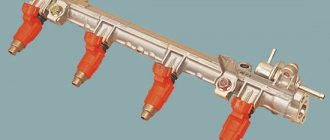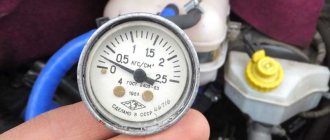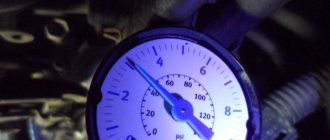Work progress
In general, there are several ways to reduce the pressure in the fuel system. If you are going to repair fuel equipment under the hood or under the bottom of the car, we recommend using the following method:
- Engage the handbrake and neutral gear;
- Turn off the ignition;
- Remove fuse No. 6 or fuel pump relay No. 2 in the mounting block;
- Start the car and let it run until it stalls due to the production of gasoline in the fuel line;
- Turn on the starter for 3 seconds. Now you can disconnect the fuel lines.
If you are planning to repair the fuel pump or remove the gas tank, then you must use the following method. To do this you will need a Phillips screwdriver.
- Engage the handbrake and neutral gear;
- Turn off the ignition;
- On cars with a hatchback and station wagon body, fold back the rear seat cushion; on cars with a sedan body, remove it;
- Bend back the floor covering and unscrew the 2 bolts securing the cover;
Remove the hatch cover above the fuel tank;
On cars with engines 21114 and 21124, press out the plastic retainer;
Disconnect the wiring harness from the fuel pump;
On cars with engines 2111 and 2112, disconnect the block with the fuel pump wires from the wiring harness by squeezing the plastic retainer;
- We start the engine and let it run until it stalls;
- Turn on the starter for 3 seconds, after which you can disconnect the fuel lines from the pump.
After finishing the work, do not forget to reconnect the wiring harness block.
Source
Lada Granta and Kalina
There may be contact between the ABS sensor cable and the brake pipe of the left front wheel with the clutch cable braid. This may cause brake fluid to leak or reduce the effectiveness of the vehicle's braking system. On Lada Granta and Kalina models that were produced after April 8, 2013, this possibility is excluded.
A corresponding order was issued and sent to all official LADA dealers indicating service work. As a result, 30,239 Lada Granta (model 21905) and Lada Kalina (VAZ models 11176 and 11196) cars with ABS and cable transmission (2181) were recalled.
If you look at a Lada Granta or Kalina car from below, you will notice that the handbrake cable runs along two sides of the body and has two attachment points on each side. The cable does not sit securely enough in the fastenings, which is why it rubs against the body and after 2000 km can wipe the bottom down to metal.
The solution to the problem is in a separate article.
Design and operation of RTD
The RTD is a valve with a diaphragm that is installed in the fuel line. When the engine is running, a certain pressure is formed in the system, which must be maintained in the required range, but since the gas pump pumps fuel continuously, the pressure increases. When the pressure increases, the RTD opens the check valve and releases excess pressure into the return system, which communicates with the fuel tank.
see also
“Peter - AT” INN 780703320484 OGRNIP 313784720500453
The Priora stopped driving as it should; when accelerating, it was as if they were holding the tail of the car; when it started moving, it failed. I exchanged consumables (spark plugs, coils, fuel pump, filter, DPZ, IRR, washed the injectors myself) I installed the pump from a known-good car - the same result. Later I got a fuel pressure gauge and took measurements
Look in the rear left arch, there is a separator tank, there is a valve on top of it inserted through an elastic band. This valve flew out, and I washed the rust and sand fuel system three times until I accidentally discovered a valve dangling in the arch and a hole from it in the separator tank, everything that was on the road flew into it
Thanks, I'll take a look today
Look in the rear left arch, there is a separator tank, there is a valve on top of it inserted through an elastic band. This valve flew out, and I washed the rust and sand fuel system three times until I accidentally discovered a valve dangling in the arch and a hole from it in the separator tank, everything that was on the road flew into it
Do you have a photo? I don’t understand, we have an absorber under the hood and only the hose from it goes to the tank
Do not confuse the adsorber with the separator.
Look in the rear left arch, there is a separator tank, there is a valve on top of it inserted through an elastic band. This valve flew out, and I washed the rust and sand fuel system three times until I accidentally discovered a valve dangling in the arch and a hole from it in the separator tank, everything that was on the road flew into it
To prevent this from happening, you need to install fender liners!
:))))) God forbid, advise some grandfather. It must be assembled on the assembly line as expected and this will not happen
fender liners without screws novline, I installed these and everything is good! There seems to be information about them on the drive too, I advise you to look!
For some reason I am not a supporter of these mud collectors.
Rdt. When the gas is released, the pressure should not fall below 3.8 by 4 points. The RTD releases the pressure, and when the engine is stopped, the pressure in the fuel rail should not drop sharply to 0. It should remain at 2-2.5-3 bar (with the internal combustion engine not running)!
did you change the fuel filter?
Change the gas station, did you change the fuel too? check adsorber electromagnetic sensor
I changed the gas station, the same fuel (in the tank and fine cleaning)
it means the star is coming to the catalyst
Kats cut out, firmware for Euro2
DMRV means))) damn there are a lot of reasons for “being held by the ass”!
The pressure was restored, another pump was replaced, the reason “does not work” was the licked key of the kv star, the damper was loose and gave incorrect readings
Change the RTD... The pressure should be 3.8 But in general, before changing anything, you need to do diagnostics and not mindlessly change everything from one extreme to another
The RTD on the Priora releases pressure above 4 atm, right?
Change the RTD... The pressure should be 3.8 But in general, before changing anything, you need to do diagnostics and not mindlessly change everything from one extreme to another
It’s impossible to find a diagnostician during the day, they’ll charge 2k for checking (whether they’ll find it or not is unknown)
My friend lives in Surgut. Also a diagnostician. Has scanners and programs. If it is not very far from you, I recommend it. He won’t take extra, and he won’t take money for unresolved problems.
If I find anything here, in the rage I might roll it to Surgut
Change the RTD... The pressure should be 3.8 But in general, before changing anything, you need to do diagnostics and not mindlessly change everything from one extreme to another
Before changing the RTD, you should check the BN; it breaks 15 times more often than the RTD. You need to measure the fuel pressure head-on, directly. It should be at least 7-8 atm. If this is the case, the RTD is changed (if the corrugated hoses in the module are in good working order and there are no leaks) If the pressure is 1 11 m
Is the car jerking, loss of agility or the engine is difficult to start? One of the reasons for such malfunctions may be related to fuel pressure. Let's look at the instructions for measuring pressure in the fuel rail, as well as features that may arise during this activity.
Checking the fuel pressure is carried out similarly for all Lada cars (Granta, Kalina, Priora, Largus, Vesta, Niva 4x4 and XRAY), because All these models have the same type of engines.
Where is it installed?
There are two options for installing an RTD: on the fuel rail and in the fuel tank.
The regulator was installed on the fuel rail on cars with a 1.5 liter injection engine. On such engines, two fuel lines come from the fuel tank: direct and return.
The regulator was installed in the fuel tank on cars with a 1.6 liter engine. In such engines, the return line was abandoned. Now the regulator directly relieves pressure in the car tank.
Quick-release fitting for fuel pipe (angle) for VAZ Granta, Kalina, Priora
Dear customers, in order to avoid errors when sending a fuel pipe fitting, in the “Comment” line indicate your car model, year of manufacture, and the shape of the fitting (straight, angle, tee, Y-shaped).
Flexible fuel hoses are located at a distance of at least 100 mm from the exhaust system elements and 250 mm from the catalytic converter.
Some models have nylon fuel hoses with quick-release connectors. If it is necessary to replace one hose, replace the hoses complete with quick-release connectors.
The fuel pipe fitting (Quick Release Adapter) is used to provide a better seal between the Quick Release and a pipe of the same or different internal diameter. Using straight, elbow, tees, Y-shaped fittings.
— A unique fitting connection ensures a hermetically sealed quick release;
— For pipes with an internal diameter from 7 mm to 10 mm;
— The quick release is resistant to extreme temperatures from -65°C to +250°C and additives to coolant, gasoline, diesel fuel, and oil.
Replacement of fuel pipes and hoses is carried out as follows:
— The pressure in the fuel system is relieved;
— All clamps securing the tube/hose to the car body are released;
— The clamp is opened and removed,
Opening the clamp (1) of the quick connector.
- Then press the clamps on both sides with one hand, and remove the tube from the connector with the other hand.
Pressing the latches and removing the tube from the quick connector
When connecting tubes and hoses, be sure to install new O-rings (as provided by the design).
On quick-release connectors, align the tube with the connector and insert the tube into the connector until it snaps into place with the clamps.
At conventional connections between a steel fuel pipe and a hose, loosen the clamp, then pull out the hose tube. Turning the tube and hose in different directions makes the disconnection process easier.
Other article numbers of the product and its analogues in catalogues: 316310110441000.
VAZ 2170, VAZ 2190, Kalina 2, Largus, Datsun, Vesta.
Any breakdown is not the end of the world, but a completely solvable problem!
How to independently replace the fuel pipe fitting on a Lada car.
With the online store Discounter AvtoAzbuka, repair costs will be minimal.
Don't forget to share the information you find with your friends and acquaintances, because they may also need it - just click one of the social networking buttons located above.
Symptoms of a problem
There are quite a lot of signs of RTD malfunctions and it is quite easy to confuse them with other problems, so before you start replacing, you need to check it, but this is discussed below.
One of the main and most obvious signs of a regulator malfunction is its jamming in the open position. For this reason, engine power drops noticeably. The engine may idle well, but the engine will not be able to develop high speeds due to lack of fuel pressure.
When starting the engine, whether cold or hot, you have to rotate the starter for a long time.
When the RTD is jammed in the closed position, excess pressure occurs, which can cause the fuel pump to fail. Excess pressure in the system leads to increased fuel consumption and incomplete combustion in the combustion chamber. The exhaust gases will have a distinct smell of gasoline with characteristic black smoke.
There are also other less noticeable signs of its malfunction:
You can learn more about the fuel system in our article.
How does the regulator (RDT) work?
The fuel system has a fuel pressure regulator. This injection system component is a conventional diaphragm valve. Its task is to maintain a constant level of pressure in the line and ramp, regardless of the operating mode of the motor. The pressure generated by the pump is maintained within 3.7-3.9 bar. If the upper threshold value is exceeded for some reason, the valve immediately directs excess fuel into the tank. When the fuel pressure is insufficient, the RTD is not able to increase it. If the valve fails, it can itself cause a decrease in pressure.
The operating features of the power supply system are discussed in detail in the diagram below.
To correctly diagnose the fuel pressure regulator, you will need to familiarize yourself in detail with the algorithm of operation of the injection system.
- When the ignition is turned on, the fuel supply pump (item 6) comes into operation. It creates the required pressure in the ramp (item 2) and the line. If after a few seconds the starter is not turned on, the on-board controller gives a command to turn off the pump power circuit.
- First, the fuel passes through filters designed for coarse and fine (item 7) cleaning. Next, it is sent to the fuel pressure regulator, after which it is supplied through the line (pos. 4) to the ramp and injectors (pos. 3).
- The start and further operation of the LADA Kalina 8 valve engine is characterized by fuel combustion. It is sprayed into the manifold by means of nozzles, after which, mixing with air in a certain proportion, it is directed into the engine chambers, where combustion occurs.
At idle speed, the RTD dumps the overwhelming share of fuel into the tank (position 5), because consumption is insignificant, and the pressure generated by the pump is constantly high.
At higher speeds the situation is different. Here the valve does not operate in reset mode, since the engine requires large portions of fuel.
Experts distinguish between two types of RTD faults. This is a decrease in the pressure level in the line or, conversely, its excessive increase. In the event of a breakdown, the LADA Kalina 8 valve element cannot be repaired. It is being replaced with a new analogue.
Examination
The check must be carried out using a special device for checking fuel pressure (pressure gauge).
This device is connected to the fuel rail fitting and the engine starts. With a working RTD on 1.5 liter engines, the fuel pressure should be from 2.9 to 3.3 kgf/cm²
Then the vacuum tube is removed from the RTD and measurements are taken again. The fuel pressure should increase by 0.2-0.7 kgf/cm².
When the engine is stopped, the pressure should drop slightly and remain in the system for about 2 hours.
Lada Granta fuel vapor recovery system:
1 - adsorber; 2 — fuel tank; 3 — bracket; 4 — steam pipe from the adsorber to the purge valve; 5 - steam line; 6 – pipeline hose from the purge valve to the throttle assembly; 7 — adsorber purge valve; 8 — throttle assembly; 9 — fuel vapor separator; 10 — valve gasket; 11 — gravity valve; 12 — hose for supplying fuel vapor to the separator; 13 — fuel tank filling pipe; 14 - steam line from the separator to the adsorber The fuel injection system and ignition system are controlled by an electronic engine control unit (ECU or controller), which continuously monitors, using appropriate sensors, the engine load, vehicle speed, the thermal state of the engine, and the optimal combustion process in the engine cylinders. A special feature of the injection system of the Lada Granta car is the synchronized operation of the injectors in accordance with the valve timing (the engine control unit receives information from the phase sensor). The ECU turns on the injectors sequentially, and not in pairs, as in asynchronous injection systems. Each injector will turn on after 720° rotation (2 turns) of the crankshaft. However, during start-up and dynamic engine operating modes, an asynchronous fuel supply method is used, without synchronization with the rotation of the crankshaft.
Replacement
Replacing the RTD on a VAZ 2110 is not a complicated process when using our instructions. Even an amateur can cope with this task. Before starting work, you need to prepare the tool and vehicle.
Necessary tool
Preparing the car
Before starting work, it is necessary to relieve the fuel pressure in the system. To do this, remove the fuel pump fuse (F15), it is located under the panel on the passenger side. We start the engine and let it run until it stalls.
Next, we remove the negative mark from the battery to avoid fire, since we will be working with flammable substances, such as gasoline.
Step-by-step instruction
- Installation of a new RTD is carried out in the reverse order. Before installing a new regulator, it is recommended to replace the sealing collar and lubricate it with gasoline before installation, so as not to damage it during the process of connecting the RTD to the ramp.
The structure of the Lada Granta fuel system and its features
The Lada Granta fuel supply system is designed to transport fuel to the car engine in the form of a working mixture consisting of gasoline and air. Each section of the system performs certain functions:
- 1. The tank is used to store fuel reserves;
- 2. The air filter cleans the air, which, mixed with fuel, enters the combustion chamber through the air duct;
- 3. The throttle valve controls the air pressure;
- 4. The submersible fuel pump supplies fuel from the tank, cleaning it through a mesh filter;
- 5. The fuel module, consisting of a fuel level sensor and a pressure regulator, is combined with a submersible electric pump to control fuel consumption.
- 6. The intake pipe and receiver serve to pump air to the intake valves.
- 7. The pressure regulator ensures uninterrupted fuel pressure in the system.
- 8. The adsorber, consisting of a container with activated carbon, absorbs gasoline vapors and, if necessary, supplies them to the intake manifold by blowing.
Power supply system LADA GRANTA
The 50-liter gasoline tank is made of special plastic and attached to the bottom of the car using steel clamps. Gasoline is supplied thanks to the fuel pump, which, under the influence of a signal from the ECU, starts working when the car’s ignition is turned on. Passing through the module into the coarse filter, the fuel flows through the tee to the fuel rail, where the excess passes through the regulator and goes back into the tank.
A special bypass valve (pressure regulator) creates constant pressure in the fuel line, due to which the fuel passes through a fuel filter made of special paper and enters the ramp, and then to the injectors and into the engine.
Reducing pressure in the power system on injection VAZs
Welcome! It is very often necessary to reduce the pressure in the power system before replacing the parts that make the car work, that is, before replacing the fuel pump, it is imperative to reduce the pressure in the power system, because if this is not done, then when the high pressure fuel pipes are disconnected from the fuel pump, a sudden ejection may occur jets of fuel from these same pipes due to pressure in the system.
Note! In order to reduce the pressure in the power system, you will need to stock up on: A thin flat screwdriver, or instead you can take an awl or even a regular Phillips screwdriver, and you will also need to stock up on a regular rag to wipe your hands after the remaining The fuel in the system will splash a little!
Real fuel consumption of Lada Granta: reviews from owners
No matter how the manufacturer declares the parameters of the optimal fuel consumption of the Lada Grant, the real picture can always be found out from those who have been using this car for many years. Depending on the type of engine, the car’s fuel consumption per 100 km has the following values (combined cycle/highway/city):
According to reviews from Lada Granta owners, the average fuel consumption per 100 km in the highway/city/combined cycle ratio is:
- on the highway from 5.5 to 6.5 liters;
- in the city from 9 to 11.8 l;
- mixed cycle from 7.5 to 8.1 l.
These indicators are relative, since in practice each car is operated in certain climatic conditions and has its own technical characteristics.
How to reduce the pressure in the power system of a fuel-injected car?
Note! Before you start, you should definitely know that in the fuel injection power system the pressure is 30 MPa (3 kgf/cm2). Based on these values, always remember that under no circumstances should you loosen the connection of the high-pressure fuel pipes while the car’s engine is running, or immediately after stopping it. But there is one interesting factor: after the car has been turned off and left unstarted for two to three hours, there is no need to reduce the pressure in the system at all, since during this time it itself drops to almost zero and rises sharply after starting engine!
1) In order to reduce the pressure, first open the hood of the car and then find the control valve in the engine compartment, which will still be closed with a protective cap that is very similar to a wheel nipple cap.
2) After the protective cap is found, take it and turn it completely by hand and after unscrewing the cap, a control valve will appear before your eyes, in the center of which there will be a spool (Indicated by an arrow), you will need to press on this spool using which be it with an awl or a screwdriver, or even with a wrench.
Grant 8 valve fuel pressure regulator where is it located?
If on the first modifications of VAZ engines with distributed injection the fuel pressure regulator was located in the engine compartment on the ramp, now the designers of the Lada Kalina 8 valve placed it inside the tank.
Now this important element of the system is located in a single fuel module along with a pump and filters for fine and coarse cleaning; this is the entire fuel system. This solution creates certain difficulties in terms of diagnosis and replacement, since partial disassembly of the tank will be required during the operation. Despite this, even the owner of a Lada Kalina, who does not have enviable experience, is able to identify and eliminate the malfunction.
About pressure drop
When it comes to pressure problems, it looks something like this:
- when the engine is running in idle mode, 2.8 atm is displayed, stable pressure, builds up quickly;
- after turning off the engine, the pressure instantly drops to 2.5 atm;
- after a minute or two it drops again to 2 atm;
- after 10 minutes – 1.6 atm.
Why does the pressure drop? There are definitely problems in the fuel system, and, as a rule, this is due to the fact that the check valve of the pump does not hold. This is why the pressure drops so quickly after the ignition is turned off.
In extreme cases, it is possible that the DDT pressure sensor fails. Methods for checking both options are given below.
Fuel pump Niva Chevrolet device
First, check the pressure in the fuel supply system by connecting a pressure gauge to the valve on the ramp in the engine compartment (see “Reducing fuel pressure in Niva Chevrolet”).
If the pressure in the system is less than 250 kPa (2.5 kgf/cm2), replace the fuel filter (see “Replacing the Niva Chevrolet fuel filter”).
If this does not help, try removing the pump and washing the mesh of its receiver (see “Repairing the Niva Chevrolet fuel pump module”).
If in this case the pressure does not increase, the fuel pump must be replaced.
You will need a “10” wrench (it is more convenient to use a socket wrench).
1. Disconnect the wire from the “–” terminal of the battery.
Fold the right side of the rear seat cushion forward.
Bend back the cut-out part of the sound insulation, under which there is a hatch cover above the fuel tank.
Remove the two fastening screws and remove the hatch cover.
Disconnect the wiring harness block from the pump adapter block.
After releasing the spring clips, remove the fuel hoses from the pump nozzles.
To prevent excess vapor pressure from displacing gasoline from the pump nozzles, remove the filler cap
Unscrew the eight nuts securing the pump (there are spring washers under the nuts).
Lift the pump up, tilt it to remove the fuel gauge sensor float from the hatch, and remove the pump along with the pressure ring.
If the pump O-ring remains on the tank, remove it and inspect it.
Replace a severely compressed, lost elasticity or torn ring.
If, when removing the pump, the storage cup remains in the tank, remove it and.
. Before reinstalling the pump, secure it to the pump body with pistons.
Place the O-ring on the pump and...
. install the pump in the tank, oriented correctly relative to the fuel hoses
When tightening the pump mounting nuts, press the ring with the pump, overcoming the resistance of the spring installed in the pump
Read more: How much does a Qashqai 2018 cost?
If the car was produced after 2009, then look at this article - Repair of the Niva Chevrolet fuel pump module
Every car engine cannot operate without fuel. It doesn’t matter at all what kind of engine is installed - injection or carburetor; without supplying the required amount of fuel, it will not work.
The Chevrolet Niva has distributed fuel injection and is equipped with an electric drive. This means that in most cases, if the fuel pump fails, the cause should be sought in the electrical circuit of the car.
Removing and replacing the fuel pump on a Niva Chevrolet
- The negative terminal is removed from the battery.
- It is necessary to reduce the pressure level in the power system. One way to unscrew the valve on the fuel rail.
- You need to get to the back seat and fold back the cushion on it on the right side - the fuel pump is located there.
- Having discovered the sound insulation, with a special cutout for the fuel tank hatch cover, you need to bend it.
- Remove this cover by first removing the screws.
Location of screws securing the decorative cover of the fuel pump
The decorative hatch has been removed and the fuel pump is visible
Hose clamps close up
The fuel pump mounting nuts are marked with arrows
Installing a new or repaired fuel pump is done in the reverse order.
Replacing the Chevrolet Niva fuel filter
- Using a 10mm socket, unscrew the plastic TF protection.
- Disconnect the fuel inlet and outlet hoses (there will be 2 clips on the sides of the snap connections that need to be pressed into the connector when removed). Despite the lack of pressure in the line, some gasoline will flow out of the hoses.
- Loosen the nut of the metal clamp tightening the bolt (if the nut is stuck, the bolt will most likely turn while turning, so in addition to a 10mm socket, you will also need a 10mm spanner).
Read more: Lumbar support for car seat
- Remove the old fuel pump from the clamp and pour the remaining gasoline in it into a container prepared in advance.
- Install a new filter. Remember that the arrow on the filter housing indicates the direction of fuel flow. All that remains is to install the hoses until the connectors click and assemble the remaining elements in the reverse order of removal.
After replacing the fuel filter on your Chevrolet Niva yourself, turn on the ignition several times for 5-8 seconds so that the fuel pump fills the system with fuel before starting the engine for the first time.
Video:
The fuel pump is broken, what should I do?
It is a very unpleasant moment when a fuel pump failure occurs, for example, on a highway or near a traffic light.
The situation becomes most tense at times of heavy traffic. If such a nuisance happens and there is no one to help, then the first thing you should do is roll the car off the roadway and try to “reanimate” the fuel pump.
Symptoms of a problem
In the arsenal of automotive tools of any caring driver there should be, along with the keys, a tester, even if in the form of a simple warning lamp and two wires.
The first sign of a malfunction on an injection engine is that the fuel pump motor is “silent” when the ignition is turned on. Accordingly, all attempts to start the engine in this case will not be successful.
In any unclear situation, remove the terminal. Very useful advice, by the way!
The driver will be very lucky if a very simple method helps, which should be taken first. To do this, remove the terminal from the battery for a while, and then put it back in and secure it. Perhaps the fuel pump will start working again.
Read more: Evb3561sv w 65 m0
Checking the power supply at the fuel pump terminals
Well, if this does not happen, continue to look for the problem. Here you should tinker and try to get to the pump itself, and use a tester or test lamp to check whether there is power at its terminals.
One end of the tester wire is installed on the car body - this will be “ground”, and the other - on the terminal connector of the fuel pump. If there is voltage, then, unfortunately, it is impossible to avoid replacing the electric motor, and if there is no voltage, the troubleshooting should be continued, already in the electrical circuit of the car.
The fuel pump screen is clogged
Not severe contamination of the filter mesh. It could be worse!
In this case, the engine starts, but does not develop full power.
Troubleshooting in an electrical circuit
The electric motor of the fuel pump rarely fails during normal operation.
Burnt contacts on the fuel pump
The main reason for this malfunction is the inexperience of the driver who does not monitor the fuel level in the gas tank, that is, when the fuel is almost completely gone. Gasoline pumps extremely do not like to work in the absence of fuel.
Fuel filters for the Lada Priora car
"Lada Priora" is a deep modification of the previous VAZ-2110 model. The fuel supply systems for the engines of these cars are very similar.
A diagram of the fuel supply system for the engines of the Lada Priora car will help you understand the nuances of its operation.
Gasoline in the Lada Priora is cleaned by two filters. The mesh filter of the electric fuel pump cuts off large fractions of contaminants. This is an inexpensive part costing about 50 rubles.
The mesh filter of the electric fuel pump performs primary filtration of fuel
Small particles are retained by the fine fuel filter.
Small particles of contaminants are retained by a fine fuel filter
The first prototype of the Lada 2170 was presented in August 2003 at the Moscow Motor Show.
Even then, this concept clearly resembled the current Priora, except that a number of exterior details had not yet been worked out. But the car went into production only 3 and a half years later, in March 2007 - the plant was busy launching another model, which reached the assembly line only by November 2004 - Lada Kalina. By the way, compared to the Kalina (not to mention the ancestor of the Priora, the “ten”) the Lada Priora project was implemented quite quickly. Innokenty Kishkurno
Which filter is better: expert opinion
When choosing a filter, pay attention to the way the fuel pipe hoses are attached. Lada Priora uses clips. Products with threaded fittings are not suitable.
You can find fuel filters from various manufacturers on sale. Their approximate cost is in the range of 200–500 rubles. It is almost impossible to assess the price-quality ratio “by eye”, since the paper filter element is installed in a non-separable metal housing.
The magazine "Behind the Wheel" conducted a study and found that all popular filters on the market are suitable for use. For this reason, the principle of “spend as much as you don’t mind” has the right to life. If it doesn’t fit and you want certainty, pay attention to the technical characteristics of the part.
Fuel filters have two main parameters: screening fineness, which determines the minimum size of retained dust, and hydraulic resistance. For reliable and uninterrupted operation of injection engine injectors, the power system filter must retain 95% of particles measuring 10 microns in diameter or less. Less is better.
But who needs a “tight” filter that impedes the movement of fuel? At a flow rate of 2 liters per minute, its hydraulic resistance - pressure drop - should not exceed 5.1 kPa. And again: the less, the better.
Another significant parameter is the area of the filter element. The standards do not standardize it, since they establish a maximum hydraulic resistance that depends on the area. But, apart from resistance, the parameter affects the duration of operation without replacement when the quality of gasoline is low.
Thus, the ideal filter should have a large surface area, retain the smallest particles and not create resistance to the flow of gasoline.
Those who want to clean the fuel to the maximum extent can be recommended to look for filters with the smallest screening fineness. When frequent replacement of a part is unacceptable, pay attention to the filter surface area.
The external differences between fuel filters from leading manufacturers are only in color and inscriptions containing the brand name
Where are the fuel filters for VAZ cars?
A coarse strainer is installed at the inlet of the electric fuel pump and is located together with the entire fuel module inside the gas tank. To get to the “mesh”, you need to open the hatch cover under the rear seat and remove the module.
The fine fuel filter is located outside the body at the rear of the car above the rear suspension beam. In order to inspect or replace it, you will need to at least lift the rear of the car with a jack, or better yet, drive into an inspection hole or use a lift.
Getting to the Lada Priora fuel filter is not easy: in this case you cannot do without an inspection hole
Lada Priora did not get its name right away.
The sedan shown in 2003 appeared under the index 2170, and the name Priora appeared only on the hatchback, which, like the sedan, was shown at the Moscow Motor Show, but a year later - in 2004. A year later, the station wagon concept was presented. By the start of sales, the entire family of new cars was already called Lada Priora. The name has not had and does not have an official decoding or translation into Russian (except for the self-evident connotation with “priority”), some sources interpret it as “primacy,” and a popular online translator somewhat unexpectedly translates this word from Italian as ... “abbess.” Innokenty Kishkurno
